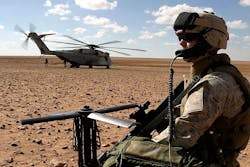SOSA open-systems standards for military embedded computing could double or triple the market
That's the word from Mark Littlefield, defense vertical product manager at Kontron America in San Diego, who's been a key member on several standards committees that promote military use of commercial off-the-shelf (COTS) components and subsystems.
The result of the SOSA effort will e "an open-systems architecture for defense that works," Littlefield said Monday in a presentation at the 2019 VITA Embedded Tech Trends (ETT) conference in San Diego.
SOSA will enable military embedded systems designers to create new system, and make substantial upgrades to existing systems, in a fraction of the time that today's open-systems standards allow. "Today this takes months to years, and this could be reduced to weeks to months," Littlefield told ETT attendees.
Much of today's open-systems military embedded computing systems rely on OpenVPX standards of the VITA open standards, open markets trade association in Oklahoma City. Yet OpenVPX has allowed a proliferation of standards that can cause confusion rather than guidance. In fact, Littlefield calls only a qualified success.
Yet the emerging SOSA standard, overseen by The Open Group in San Francisco, has the potential to sharpen the OpenVPX standards such that these standards promote true interoperability among third-party suppliers, help prevent vendor lock, and affordable systems development in a relatively short period of time.
The emerging SOSA standard should firm-up by this spring, and already several embedded computing companies have introduced SOSA-aligned products -- among them Kontron, Pentek Inc. in Upper Saddle River, N.J.; Elma Electronic in Fremont, Calif.; and Annapolis Micro Systems Inc. in Annapolis, Md. Additional companies are expected to launch SOSA-aligned products over the next few months.
The SOSA standards group involves technical experts from the U.S. military services, and has support from top leaders in the Pentagon. A memo signed earlier this month by U.S. secretaries of the Army, Navy, and Air Force, calls for military service acquisition executives and program executive officers to use open-systems standards like SOSA "to the maximum extent possible."
The memo calls out existing and emerging open-systems standards that fall under the umbrella of the so-called Modular Open Systems Approach (MOSA) project, including SOSA; Future Airborne Capability Environment (FACE); Vehicular Integration for C4ISR/EW Interoperability (VICTORY); and Open Mission Systems/Universal Command and Control Interface (OMS/UCI).
"MOSA supporting standards should be included in all requirements, programming, and development activities for future weapon system modification and new-start development programs to the maximum extent possible," stated this memo, signed by Navy Secretary Richard Spencer, Army Secretary Mark Esper, and Air Force Secretary Heather Wilson.
Among the big advantages of SOSA is its reduction of OpenVPX circuit card slot profiles essentially to three -- two basic profiles and a secondary profile for 3U and 6U OpenVPX, Littlefield points out. SOSA "is a complete common infrastructure for developing and maintaining sensor systems over several generations," Littlefield says.
In answer to critics who say SOSA guidelines may be too limiting, and threaten to reduce powerful enabling technologies to commodities, Littlefield says "I would trade commoditization for something that doubles or triples our market."
Ready to make a purchase? Search the Military & Aerospace Electronics Buyer's Guide for companies, new products, press releases, and videos

